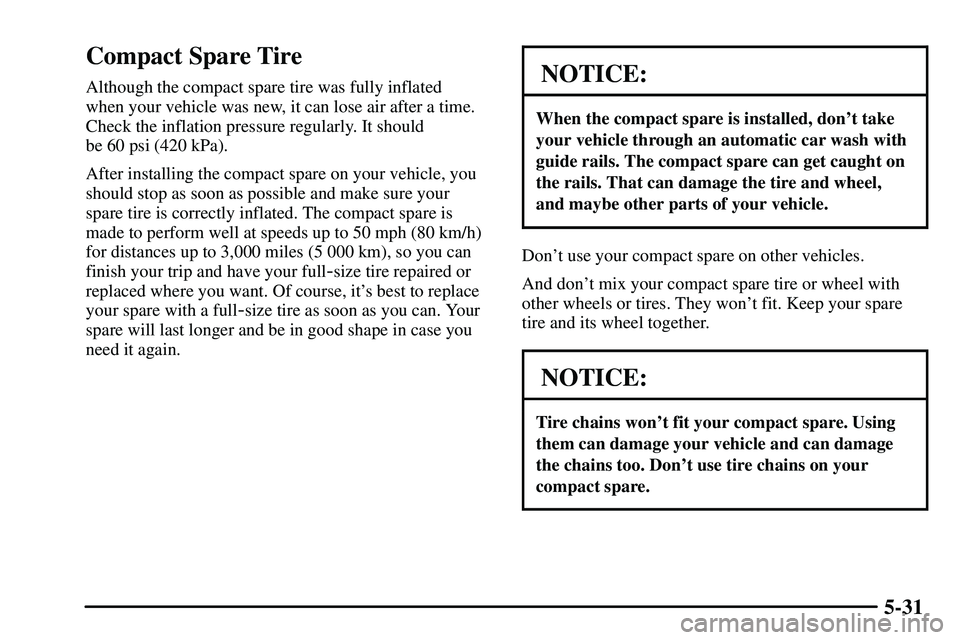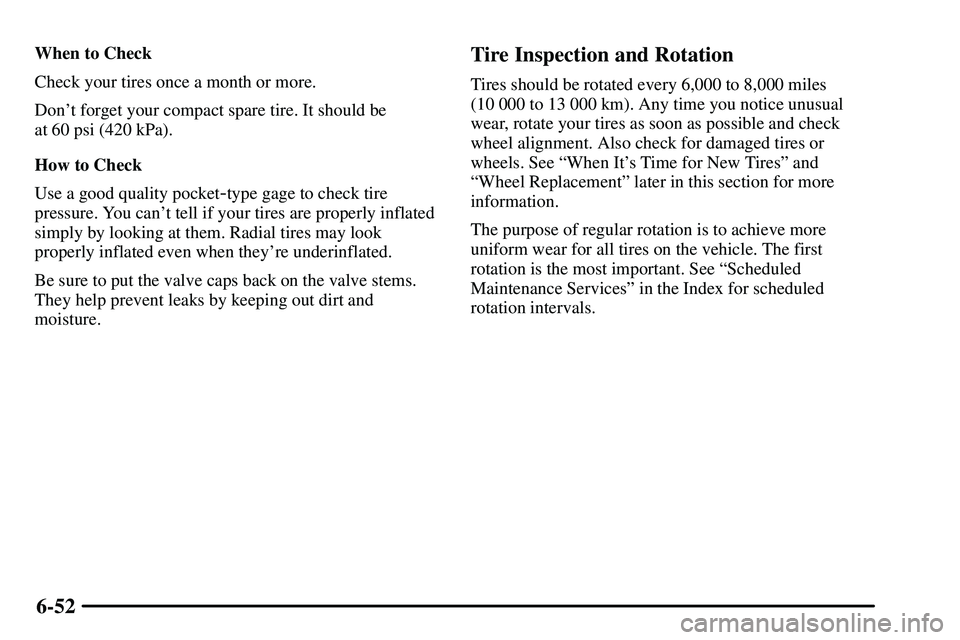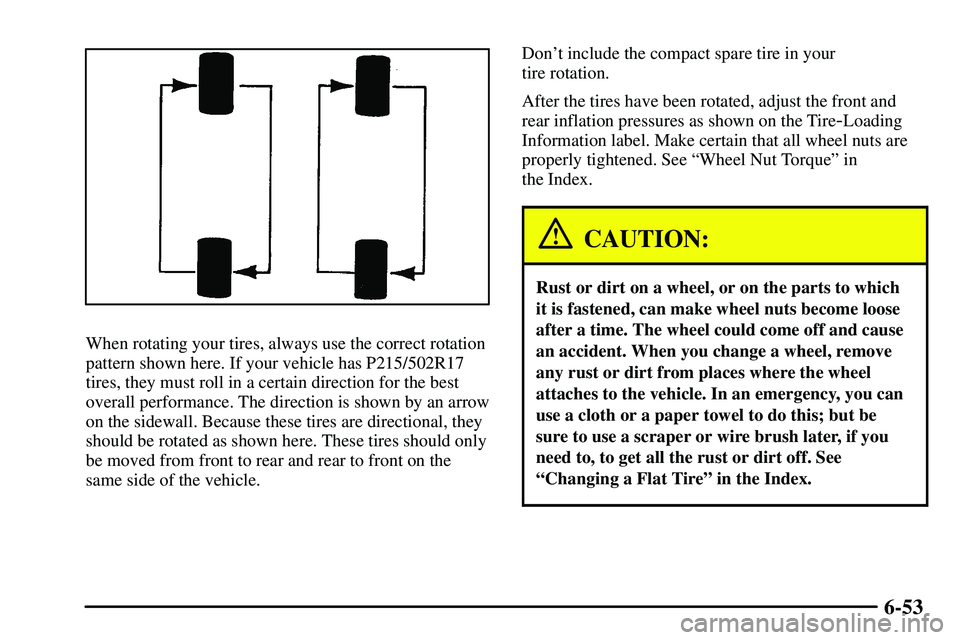Page 230 of 381
5-19
The following steps will tell you how to use the jack and
change a tire.
Removing the Spare Tire and Tools
The jack, wheel wrench, jack handle and spare tire are
stowed in the rear of the vehicle, underneath the floor of
the cargo area. To remove the spare tire and tools do the
following:
1. Turn the two lock knobs
on the floor of the cargo
area to UNLOCK.
Page 233 of 381
5-22
The tools you'll be using include the jack (A), jack
handle (B) and wheel wrench (C).
6. Attach the jack handle to the jack.
7. Turn the jack handle clockwise to raise the lift head.
Removing the Flat Tire and Installing the
Spare Tire
1. Using the wheel wrench, loosen all the wheel nuts.
Don't remove them yet.
Page 235 of 381
5-24
3. Raise the vehicle by turning the jack handle
clockwise. Raise the vehicle far enough off the
ground so there is enough room for the compact
spare tire to fit underneath the wheel well.
4. Remove all the wheel
nuts and take off the
flat tire.
5. Remove any rust or dirt
from the wheel bolts,
mounting surfaces and
spare wheel.
Page 239 of 381
5-28 Storing the Flat Tire and Tools
CAUTION:
Storing a jack, a tire or other equipment in the
passenger compartment of the vehicle could
cause injury. In a sudden stop or collision, loose
equipment could strike someone. Store all these
in the proper place.
Return the jack, jack handle and wheel wrench to the
storage area. The compact spare tire storage area is
designed only for the compact spare tire, the standard
tire cannot be stored there.
To store the flat tire do the following:
1. If your vehicle has aluminum wheels, remove the
center wheel cap before storing the flat tire.
2. Place the flat tire on the rear cargo area floor panel
with the outer side of the wheel facing up
3. Use the tire tie
-down belts located under the floor
panel to secure the flat tire.
4. Hook the belts (end closest to the buckle) to the rear,
upper tie
-down hooks.
Page 241 of 381
5-30 Storing the Spare Tire and Tools
CAUTION:
Storing a jack, a tire or other equipment in the
passenger compartment of the vehicle could
cause injury. In a sudden stop or collision, loose
equipment could strike someone. Store all these
in the proper place.
A. Jack
B. Wheel Wrench
C. BoltD. Spare Tire
E. Jack Handle
F. Nut
Return the jack, jack handle, wheel wrench and compact
spare tire to the storage area. When storing the compact
spare tire, put it in place with the inner side of the wheel
facing up. The compact spare tire storage area is
designed only for the compact spare tire, the standard
tire cannot be stored there.
Page 242 of 381

5-31
Compact Spare Tire
Although the compact spare tire was fully inflated
when your vehicle was new, it can lose air after a time.
Check the inflation pressure regularly. It should
be 60 psi (420 kPa).
After installing the compact spare on your vehicle, you
should stop as soon as possible and make sure your
spare tire is correctly inflated. The compact spare is
made to perform well at speeds up to 50 mph (80 km/h)
for distances up to 3,000 miles (5 000 km), so you can
finish your trip and have your full
-size tire repaired or
replaced where you want. Of course, it's best to replace
your spare with a full
-size tire as soon as you can. Your
spare will last longer and be in good shape in case you
need it again.
NOTICE:
When the compact spare is installed, don't take
your vehicle through an automatic car wash with
guide rails. The compact spare can get caught on
the rails. That can damage the tire and wheel,
and maybe other parts of your vehicle.
Don't use your compact spare on other vehicles.
And don't mix your compact spare tire or wheel with
other wheels or tires. They won't fit. Keep your spare
tire and its wheel together.
NOTICE:
Tire chains won't fit your compact spare. Using
them can damage your vehicle and can damage
the chains too. Don't use tire chains on your
compact spare.
Page 297 of 381

6-52
When to Check
Check your tires once a month or more.
Don't forget your compact spare tire. It should be
at 60 psi (420 kPa).
How to Check
Use a good quality pocket
-type gage to check tire
pressure. You can't tell if your tires are properly inflated
simply by looking at them. Radial tires may look
properly inflated even when they're underinflated.
Be sure to put the valve caps back on the valve stems.
They help prevent leaks by keeping out dirt and
moisture.
Tire Inspection and Rotation
Tires should be rotated every 6,000 to 8,000 miles
(10 000 to 13 000 km). Any time you notice unusual
wear, rotate your tires as soon as possible and check
wheel alignment. Also check for damaged tires or
wheels. See ªWhen It's Time for New Tiresº and
ªWheel Replacementº later in this section for more
information.
The purpose of regular rotation is to achieve more
uniform wear for all tires on the vehicle. The first
rotation is the most important. See ªScheduled
Maintenance Servicesº in the Index for scheduled
rotation intervals.
Page 298 of 381

6-53
When rotating your tires, always use the correct rotation
pattern shown here. If your vehicle has P215/502R17
tires, they must roll in a certain direction for the best
overall performance. The direction is shown by an arrow
on the sidewall. Because these tires are directional, they
should be rotated as shown here. These tires should only
be moved from front to rear and rear to front on the
same side of the vehicle.Don't include the compact spare tire in your
tire rotation.
After the tires have been rotated, adjust the front and
rear inflation pressures as shown on the Tire
-Loading
Information label. Make certain that all wheel nuts are
properly tightened. See ªWheel Nut Torqueº in
the Index.
CAUTION:
Rust or dirt on a wheel, or on the parts to which
it is fastened, can make wheel nuts become loose
after a time. The wheel could come off and cause
an accident. When you change a wheel, remove
any rust or dirt from places where the wheel
attaches to the vehicle. In an emergency, you can
use a cloth or a paper towel to do this; but be
sure to use a scraper or wire brush later, if you
need to, to get all the rust or dirt off. See
ªChanging a Flat Tireº in the Index.